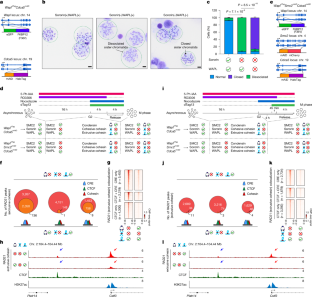Extensive mutual influences of SMC complexes shape 3D genome folding
IF 48.5
1区 综合性期刊
Q1 MULTIDISCIPLINARY SCIENCES
引用次数: 0
Abstract
Mammalian genomes are folded through the distinct actions of structural maintenance of chromosome (SMC) complexes, which include the chromatin loop-extruding cohesin (extrusive cohesin), the sister chromatid cohesive cohesin and the mitotic chromosome-associated condensins1–3. Although these complexes function at different stages of the cell cycle, they exist together on chromatin during the G2-to-M phase transition, when the genome structure undergoes substantial reorganization1,2. Yet, how the different SMC complexes affect each other and how their interactions orchestrate the dynamic folding of the three-dimensional genome remain unclear. Here we engineered all possible cohesin and condensin configurations on mitotic chromosomes to delineate the concerted, mutually influential action of SMC complexes. We show that condensin disrupts the binding of extrusive cohesin at CCCTC-binding factor (CTCF) sites, thereby promoting the disassembly of interphase topologically associating domains (TADs) and loops during mitotic progression. Conversely, extrusive cohesin impedes condensin-mediated mitotic chromosome spiralization. Condensin reduces peaks of cohesive cohesin, whereas cohesive cohesin antagonizes condensin-mediated longitudinal shortening of mitotic chromosomes. The presence of both extrusive and cohesive cohesin synergizes these effects and inhibits mitotic chromosome condensation. Extrusive cohesin positions cohesive cohesin at CTCF-binding sites. However, cohesive cohesin by itself cannot be arrested by CTCF molecules and is insufficient to establish TADs or loops. Moreover, it lacks loop-extrusion capacity, which indicates that cohesive cohesin has nonoverlapping functions with extrusive cohesin. Finally, cohesive cohesin restricts chromatin loop expansion mediated by extrusive cohesin. Collectively, our data describe a three-way interaction among major SMC complexes that dynamically modulates chromatin architecture during cell cycle progression. Orthogonal acute inducible degradation cell lines are used to delineate the mechanisms of how extrusive cohesin, cohesive cohesin and condensin interact to remodel chromosome architecture from interphase to mitosis.


SMC复合物的广泛相互影响塑造了三维基因组折叠
哺乳动物基因组的折叠是通过染色体(SMC)复合体的不同结构维持作用进行的,这些复合体包括染色质环挤压内聚蛋白(挤出内聚蛋白)、姐妹染色单体内聚蛋白和有丝分裂染色体相关凝聚蛋白1,2,3。尽管这些复合物在细胞周期的不同阶段发挥作用,但在基因组结构经历实质性重组的g2 - m阶段,它们一起存在于染色质上1,2。然而,不同的SMC复合物如何相互影响以及它们的相互作用如何协调三维基因组的动态折叠仍然不清楚。在这里,我们设计了有丝分裂染色体上所有可能的内聚蛋白和凝聚蛋白构型,以描绘SMC复合物的协调,相互影响的作用。我们发现凝缩蛋白破坏挤压黏结蛋白在ccctc结合因子(CTCF)位点的结合,从而促进有丝分裂过程中间期拓扑相关结构域(TADs)和环的分解。相反,挤出性内聚蛋白阻碍凝聚蛋白介导的有丝分裂染色体螺旋化。凝聚蛋白降低内聚蛋白的峰,而内聚蛋白拮抗凝聚蛋白介导的有丝分裂染色体的纵向缩短。挤出性和内聚性内聚蛋白的存在协同这些作用并抑制有丝分裂染色体凝聚。挤出式内聚将内聚蛋白定位在ctcf结合位点。然而,内聚的内聚蛋白本身不能被CTCF分子阻滞,不足以建立tad或环。此外,它缺乏环挤压能力,这表明内聚性黏结蛋白与挤出性黏结蛋白具有不重叠的功能。最后,内聚性内聚蛋白限制了挤出性内聚蛋白介导的染色质环扩张。总的来说,我们的数据描述了在细胞周期进程中动态调节染色质结构的主要SMC复合物之间的三向相互作用。
本文章由计算机程序翻译,如有差异,请以英文原文为准。
求助全文
约1分钟内获得全文
求助全文
来源期刊

Nature
综合性期刊-综合性期刊
CiteScore
90.00
自引率
1.20%
发文量
3652
审稿时长
3 months
期刊介绍:
Nature is a prestigious international journal that publishes peer-reviewed research in various scientific and technological fields. The selection of articles is based on criteria such as originality, importance, interdisciplinary relevance, timeliness, accessibility, elegance, and surprising conclusions. In addition to showcasing significant scientific advances, Nature delivers rapid, authoritative, insightful news, and interpretation of current and upcoming trends impacting science, scientists, and the broader public. The journal serves a dual purpose: firstly, to promptly share noteworthy scientific advances and foster discussions among scientists, and secondly, to ensure the swift dissemination of scientific results globally, emphasizing their significance for knowledge, culture, and daily life.
 求助内容:
求助内容: 应助结果提醒方式:
应助结果提醒方式:


